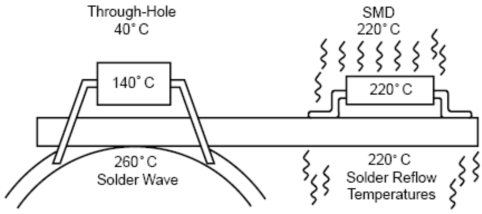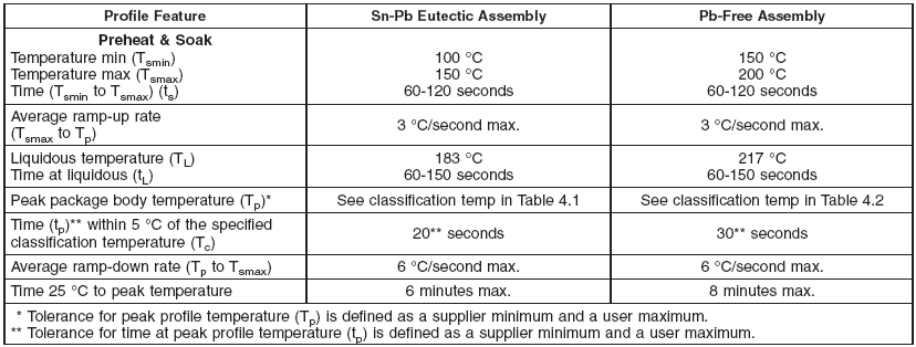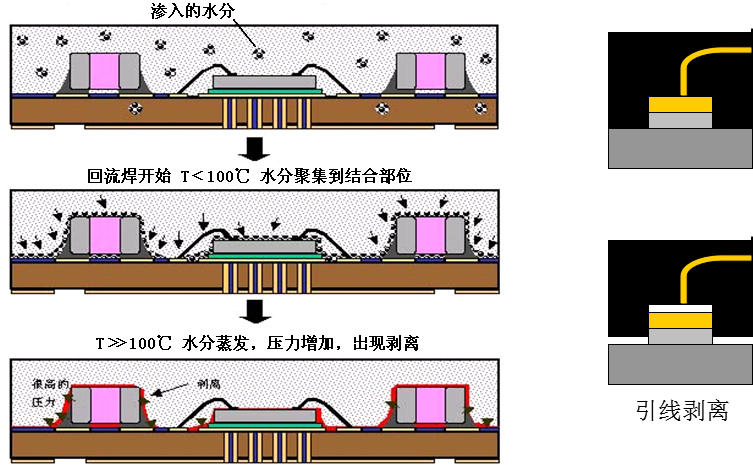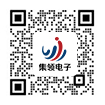Humidity Hazards to Reliability
electrical short circuit
metal oxidation
Electrochemical corrosion
MSD Hazards
MSD hazard acts during welding, including heating for repairs.
Pay attention to and study MSD issues, and play a guiding role in processing, transportation, device selection and warehouse management. The advancement of technology has deepened the MSD problem, and the number of surface array package devices (such as BGA, CSP) is increasing. Area array packaged devices tend to be packaged in tape and reel, which can hold very many devices per reel, which increases the exposure time of the devices.
Lead-free mounting. Pb-free alloys have higher peak reflow temperatures, which may degrade the MSD's humidity sensitivity by at least a notch or two.
MSD (Moisture Sensitive Devices) Moisture Sensitive Devices MSD mainly refers to non-hermetic SMD devices. Includes plastic encapsulation, other water permeable polymer encapsulation (epoxy, silicone, etc.). Generally, ICs, chips, electrolytic capacitors, LEDs, etc. are all non-hermetic SMD devices.
MSL (Moisture Sensitivity Level) Moisture Sensitivity Level
MSD grading, the higher the grade, the more sensitive it is to humidity and the more susceptible it is to moisture damage. Can be divided into 1, 2, 2a, 3, 4, 5, 5a, 6, where 1st grade devices are not MSDs.
The semiconductor components packaged by the MSD packaging material with ceramic and metal materials have better air tightness and higher cost, and are suitable for applications with high reliability requirements. Semiconductor components encapsulated in plastic have poor airtightness but low cost, so they have become the mainstream of civilian products such as televisions, telephones, computers, and radios.
The devices we use now are mainly based on epoxy resin.
Common terms
MBB: Moisture Barrier Bag
HIC: Humidity Indicator Card
Floor life: The time the MSD leaves the sealed environment and is exposed to air
Shelf life: The minimum time MSD devices can be stored in a dry bag, usually a minimum of 12 months from the date the bag was sealed
references:
J-STD-033B.1 January 2007
J-STD-020D June 2007
J-STD-033A year 2002
JET113 May 1999
Intel Packaging Technology
- STD-033: Handling, Packaging, Shipping of MSD.
J-STD-020: MSL Taxonomy.
JEP113: MSD Label Description.

In the reflow zone, the entire device should be above 183 degrees for about 60-150s, and the maximum temperature is 220-235 degrees (SnPb eutectic)

The peak temperature and preheating temperature of lead-free soldering are higher, and the maximum temperature is 245-260 degrees.
Under the high temperature of the reflow zone, the moisture inside the device will expand rapidly, the coordination between different materials of the device will be out of adjustment, and various connections will have adverse changes, resulting in delamination or bursting of the device. Performance is affected or destroyed. If the damage is serious, the appearance of the device will be deformed, cracks, etc. (usually we call this phenomenon the "popcorn" phenomenon). Like ESD damage, these changes are mostly invisible to the naked eye, and MSDs do not appear to fail completely during testing.


The parameters affecting MSD are mainly the device material and the device geometry, and the geometry mainly refers to the thickness.
1. The effect of thickness on the moisture sensitivity of the device is reflected in two aspects:
1. The temperature of the device with large thickness (large volume) rises slowly, and the damage time is shorter than that of the device with small thickness (small volume).
2. It takes a long time for moisture to fully penetrate a device with a large thickness, that is, its Floor life is relatively long.
2. The influence of materials on the moisture sensitivity of the device is reflected in the water permeability
Moisture Sensitivity Rating
Lifetime exposed to air
time surroundings
1 unlimited ≤30℃/85%RH
2 one year ≤30℃/60%RH
2a around ≤30℃/60%RH
3 168 hours ≤30℃/60%RH
4 72 hours ≤30℃/60%RH
5 48 hours ≤30℃/60%RH
5a 24 hours ≤30℃/60%RH
6 required on the label ≤30℃/60%RH
-
Tel
19065022716 -
Wechat


